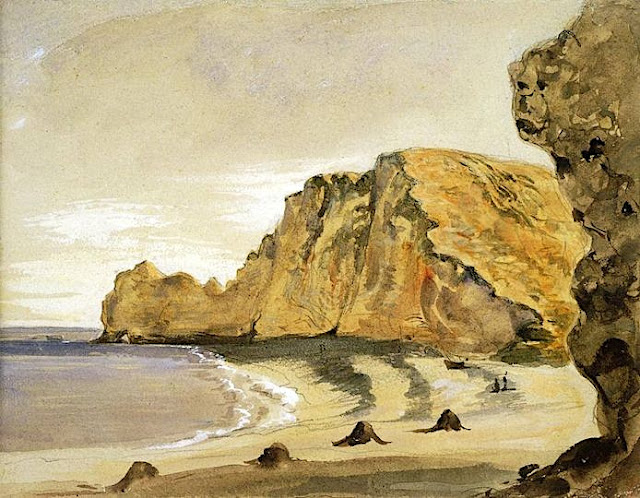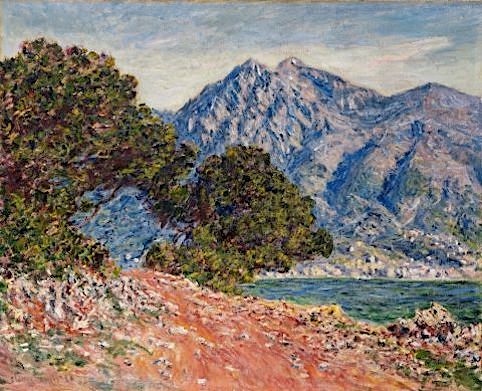CLAUDE MONET (1840-1926)
Mont Agel (1,151m - 3,776 ft)
France - Principauté de Monaco - Italy border
In "La Corniche near Monaco, Le Mont Agel", oil on canvas, 65 x 82cm, Private Collection
About this painting
Claude Monet painted the Mont Agel quite a number of times, but in ecah painting colors and general impression are totally different. One can compare
the different paintings of that mountain he done. this one is supposed to have been painted at 1the sunset. Monet, like the japanese painters ,and particularly
Hokusai who painted the 36 views of Mount Fuji, reproduced the
same artistic behavior by painting series of the same mountains, in the
same place, at different hours of the day or different seasons. At Cap
Martin and Mont Agel, Monet painted about ten of them.
The mountain
Mont Agel (1,151m - 3,776 ft)
is a summit of the Alps located in the South of France, overlooking
part of the French Riviera, Monaco, Beausoleil, Roquebrune-Cap-Martin...
exactly as shwon in the Monet's painting above !
It has held a
historic strategic position since Antiquity and still houses military
aerial detection installations today. Mount Agel is precisely located in
the French commune of Peille, ( Provence-Alpes-Côte d'Azur region). It
rises in the Prealps of Nice and constitutes the highest point of the
Monegasque watershed. The highest point of the principality, of Monaco,
on the slopes of this mountain, can be reached by the Chemin des
Révoires. A massive summit, Mount Agel is visible from a great distance:
from certain districts of Nice as well as from a large part of the
French Riviera between Cannes, Antibes, Nice, Antibes, and the
Principality of Monaco and likewise from the Italian Riviera to around
Vintimiglia and Bordighiera.
The history of Mount Agel begins with
the Celto-Ligurian tribes who occupied the site and some of whose
members were involved in the boarding and looting of boats engaged in
cabotage. They are submitted from 23 to 13 BC. BC by the Romans who
restored the old coastal route passing through the slopes of Mount Agel
to link Ventimiglia to Narbonne Gaul and forming part of the Via
Aurelia.
From 1931, new elements of fortification were built within the framework of the Maginot line.
Mount
Agel now houses a large work of artillery equipped with turrets, linked
together by deeply buried galleries. During the fighting of June 1940,
his shots participated in the defense of Menton and supported the
outpost of Pont-Saint-Louis and the work of Cap-Martin.
Until 2012, the 943 Capitaine Auber air base of the French Air Force was located there.
Today,
only radars remain, which continue their watch in automatic mode, the
information being transmitted and used by the Detection and Control
Center at 942 Lyon-Mont Verdun air base.
Mount Agel also shelters on
its slopes, the Monte-Carlo Golf Club, a very selective club. A little
to the east of the golf course is the transmitter center of Fontbonne.
Until its recent redevelopment, there were various protohistoric
constructions.
Close to Mount Agel and the golf course is also the summer residence of Princes of Monaco (Rocagel site).
The painter
The painter Oscar-Claude Monet better known as Claude Monet
was a founder of French Impressionist painting, and the most consistent
and prolific practitioner of the movement's philosophy of expressing
one's perceptions before nature, especially as applied to plein-air
landscape painting. The term "Impressionism" is derived from the title
of his painting « Impression, soleil levant » (Impression, Sunrise),
which was exhibited in 1874 in the first of the independent exhibitions
mounted by Monet and his associates as an alternative to the Salon de
Paris.
Monet's ambition of documenting the French countryside led
him to adopt a method of painting the same scene many times in order to
capture the changing of light and the passing of the seasons exactly
like the japanese artist Hokusai (1760-1849) did with his 36 views of Mount Fuji.
Monet repeated this kinf of "exercise de stylee with his series on Les Petites Dalles. and Kolsass mountain.
Monet
has been described as "the driving force behind Impressionism". Crucial
to the art of the Impressionist painters was the understanding of the
effects of light on the local colour of objects, and the effects of the
juxtaposition of colours with each other. Monet's long career as a
painter was spent in the pursuit of this aim.
In 1856, his chance
meeting with Eugene Boudin, a painter of small beach scenes, opened his
eyes to the possibility of plein-air painting. From that time, with a
short interruption for military service, he dedicated himself to
searching for new and improved methods of painterly expression. To this
end, as a young man, he visited the Paris Salon and familiarised himself
with the works of older painters, and made friends with other young
artists.[54] The five years that he spent at Argenteuil, spending much
time on the River Seine in a little floating studio, were formative in
his study of the effects of light and reflections. He began to think in
terms of colours and shapes rather than scenes and objects. He used
bright colours in dabs and dashes and squiggles of paint. Having
rejected the academic teachings of Gleyre's studio, he freed himself
from theory, saying "I like to paint as a bird sings."
In 1877 a
series of paintings at Gare St-Lazare had Monet looking at smoke and
steam and the way that they affected colour and visibility, being
sometimes opaque and sometimes translucent. He was to further use this
study in the painting of the effects of mist and rain on the landscape.
The study of the effects of atmosphere were to evolve into a number of
series of paintings in which Monet repeatedly painted the same subject
in different lights, at different hours of the day, and through the
changes of weather and season. This process began in the 1880s and
continued until the end of his life in 1926.
His first series
exhibited as such was of Haystacks, painted from different points of
view and at different times of the day. Fifteen of the paintings were
exhibited at the Galerie Durand-Ruel in 1891. In 1892 he produced what
is probably his best-known series, Twenty-six views of Rouen Cathedral.
In these paintings Monet broke with painterly traditions by cropping the
subject so that only a portion of the facade is seen on the canvas. The
paintings do not focus on the grand Medieval building, but on the play
of light and shade across its surface, transforming the solid masonry.
Other series include Peupliers, Matins sur la Seine, and the Nenuphars
that were painted on his property at Giverny. Between 1883 and 1908,
Monet traveled to the Mediterranean, where he painted landmarks,
landscapes, and seascapes, including a series of paintings in Antibes
(above) and Venice. In London he painted four series: the Houses of
Parliament, London ; Charing Cross Bridge ; Waterloo Bridge, and Views
of Westminster Bridge. Helen Gardner writes: "Monet, with a scientific
precision, has given us an unparalleled and unexcelled record of the
passing of time as seen in the movement of light over identical forms."
___________________________________________
2022 - Wandering Vertexes...
by Francis Rousseau
Falaise%20de%20Deippe%201882%20.jpg)





-Tsukada_Island_in_the_Musashi_province%20n%C2%B0%2016-%201830.jpg)

%20-_The_Tyrol-%20Austria%20.jpg)
-%20falaises-pres-de-dieppe-%20-1896.jpg)

,%201885%E2%80%931886-%20Barnes%20Foundation.jpg)




